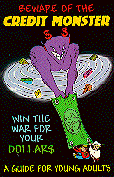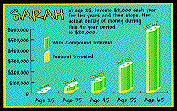

![]()

|
Beware of the Credit Monster:
Carole M. Wallace.
Grades 10 and up / Ages 15 and up.
**/4
|
THESE TWO TAPES ARE DIVIDED into four programs, each a lively discussion between two financially naive radio announcers and the fictitious investment advisor, Sage Counsellor. For someone with little or no experience they offer sound advice. The major weakness is that much of the information is American and not relevant to a Canadian audience. Canadians, for example, can't deduct the cost of mortgage interest from their income tax while Americans can.

The first program
answers the question "Who is the credit monster?" by explaining the
dangers of buying on credit. The advice to teenagers who are beginning to
earn interest from part-time jobs is excellent. The tape urges young
adults to use money wisely, to save and earn interest rather than to pay
interest on debt.
In the interests
of verisimilitude, the interviews are interrupted by commercial messages.
But while these ads illustrate the points made in the program, they
aren't really necessary.
The program two
explains compound interest and discusses how to make financial security a
priority by saying, earning interest, and deferring taxes. Again, the
advice on deferring taxes isn't relevant to Canadians because there is
no exact American equivalent of RRSPs.
The third program
discusses the risk involved in various types of loans and investments,
from savings accounts to loans to family members and friends. It also
explains how banks make money by lending customer's money, and the
differences between government and corporate bonds.
There is a brief
and informative discussion about investing in stocks and how this can be
riskier than buying bonds. It also points out that stocks can provide
greater returns through the combination of dividends and capital gains.
In addition, there is a useful discussion on inflation and how it can
erode interest income.
Program four
discusses how to accumulate money through savings accounts, savings
bonds, and mutual funds. There is reference to the difference between
front-end and no-load mutual funds, but this is too brief to be of much
value. Program four also suggests that everyone should establish an
emergency fund equal to three months' worth of living expenses. Once this
fund is set up, the money should be put into something secure and
eventually into the equivalent of an RRSP.
The tapes are
easy to follow and well suited to a young audience. But the American
focus makes them less valuable to a Canadian audience.
Recommended with reservations.
Tom Chambers is a professor at Canadore College in North Bay Ontario.
To comment on this title or this review, send mail to cmeditor@mts.net.
![]()
Copyright © 1996 the Manitoba Library Association.
Reproduction for personal use is permitted only if this copyright notice
is maintained. Any other reproduction is prohibited without permission.
Published by
The Manitoba Library Association
ISSN 1201-9364
![]()